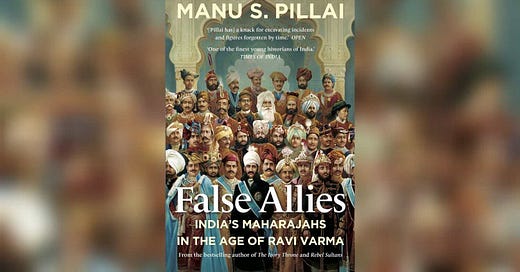“False Allies” by Manu S. Pillai
A book about India’s Maharajas and how they were misrepresented.
I speak a lot about nuance. The world increasingly appears to lack it, if not outright fear it.
Don’t get me wrong, nuance is hard and it is easier to accept and revel in simple narratives. However, the world firmly rejects simple narratives, the multitudes it contains simply not giving consent to being reduced to a clever line or a crisp tweet.
I find this most true for history, where nuance is usually sacrificed at the altar of a pompous tweet or an unceremonious WhatsApp forward.
India’s Maharajas of the yesteryears are one such group from whom nuance was robbed and this book does a splendid job of bathing them in researched meaning.
An Orientalist View
Perhaps the often simplistic view of India’s former Maharajas as merely hedonistic, fat, pleasure-loving animal hunters is one that is firmly embedded in the Indian psyche. The truth is quite further away from this fiction. Sure, some of them did fit this bill, but more of them came from complex houses and played pivotal roles in India’s tryst with destiny. William Dalrymple’s Anarchy is another book that does the same for the complex edifice of the East India Company.
The book showcases several such examples, from the Kallars to the Rajputs, with Travancore, Mysore, and Baroda alike showcasing ideas across the political spectrum and some of these princely states best demonstrating what an “India ruled by Indians” could look like.
If anything, the reductionist version of these Maharajas is an orientalist one- fixing these kings into boxes that go well with the British narrative of decadence.
The Bureaucrats as Rulers
What surprised me about this book and Pillai’s elaborate research is how the ‘Dewans’ or the ministers in charge of some of these states played an immense role in nation-building. While the likes of Visvesvaraya are well known for his developmental feats, the likes of Madhava Rao, A. Seshiah Sastri, and the indomitable and shrewd C.P Ramaswami Iyer displayed political acumen that would put contemporary legislators to shame.
The sheer scope of envisioning actual change through bureaucracy and behind-the-doors negotiations is one of those great unseens that only the narrative forces of history like this book achieve in a fine display. This is certainly to the dismay of the more academic aspects of the discipline where terse language and forced tools cause readability to suffer.
Using Ravi Varma’s paintings as a convenient narrative tool to stitch a tapestry, Pillai has painted a breathtaking analysis of this often forgotten aspect of pre-Independence India.
Of course, you need not pick a paintbrush or enlist as a false ally to support this newsletter. Do share it and follow it if you found it of value. Drop a comment to break the veil of solitude. Until the next time, do keep reading and thinking.



